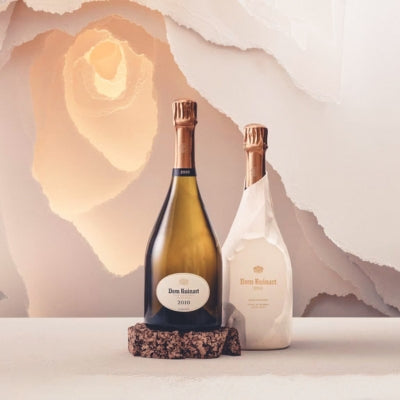
The secrets of Champagne Ruinart
Recognized as the oldest Champagne house, Ruinart’s pedigree and heritage distinguish it from the Grandes Marques. A modest approach to publicity cultivates its following purely on the foundation of exceptional winemaking and a genuine appreciation of creativity.
On a recent visit to the estate, we had the privilege of a fascinating behind-the-scenes experience, revealing the inner workings of a house that feels like a hidden gem among the more ostentatious voices of Champagne.
The legacy of Champagne Ruinart
The history of the house is intrinsically tied to the history of Champagne itself. In May 1728, King Louis XV officially authorized the commercialization of bottled Champagne, as before this Champagne could only be transported via barrel, confining it to its immediate region. This edict is often considered the birth of Champagne as we know it today.
First on the scene
An entrepreneurial textile merchant named Nicolas Ruinart jumped at the chance to realize his Uncle, Dom Thierry Ruinart’s, vision of the new “wine with bubbles” by establishing Maison Ruinart in September 1729 – the very first Champagne-producing company.
Initially, the earliest Ruinart Champagnes were given to textile customers to sweeten rapport; charming gifts woven into the fabric of the brand. However, this evolved into the eventual termination of the textile business altogether, thanks to the ultimate success of the wines.
The crayères
Maison Ruinart is also sat upon a goldmine – the crayères; eight kilometers of labyrinthine chalk caves reaching depths of almost 40 meters. Originally, this network of white quarries was used to extract the raw building material that so much of Champagne’s architecture is constructed from, but their new purpose in winemaking was immediately realized. The consistently cool and humid conditions provide the ideal sanctuary for the delicate processes of Champagne élevage.
Now a UNESCO World Heritage site, the crayères serve as a poignant visual demonstration of chalk’s crucial role in Champagne making; a cross-section of the terroir that forms the perfect ecosystem for some of the world's most valuable land.
Innovation in winemaking at Maison Ruinart
Exploring the utterly captivating crayères, learning about the processes that define the house style, and tasting the wines brought into sharp focus the level of innovative craftsmanship that goes on at Maison Ruinart.
Secondary fermentation under cork
As part of the pursuit of the ultimate élevage process, Cellar Master Frédéric Panaïotis has reintroduced aging under cork. The secondary fermentation and lees aging process would normally occur under crown cap, but Maison Ruinart has been experimenting with this traditional method since the 2010 vintage.
Developing highly nuanced complexity and more unique flavor profiles, the 2010 Dom Ruinart Blanc de Blancs shows remarkable tension and even makes technically better vintages “seem a bit simple” by comparison.
Along with this traditional process, comes the need for the ancient art of manual disgorgement, a technique long since forgotten in modern Champagne production and only attempted by Ruinart’s most skilled practitioners.
‘Second Skin’ eco packaging
Ruinart is also making waves with its commitment to sustainability, particularly through its 'second skin' packaging. Replacing traditional cardboard boxes with a lightweight, eco-friendly alternative made from 99% paper and 1% glue has resulted in packaging 9 times lighter than the previous interaction and a drastically reduced carbon footprint.
The 2010 vintage of Dom Runiart is the first of Ruinart’s Prestige Cuvées to be released with this sustainable packaging, but exclusivity is not the game here, as the concept has been released as a free-to-use innovation with the hopes of large-scale adoption across the industry. This initiative has been met with tremendous enthusiasm from consumers, reflecting a growing awareness and appreciation for sustainable practices in the luxury sector.
This move also pays further homage to the history of the house. Among some of the very oldest vintages found in the cellars was discovered an original papier mache version [pictured] from a time before cardboard was the norm.
Dom Ruinart
After the tour had concluded, we were invited back to taste a range of Maison Ruinart’s Champagnes, chief among which were the Dom Ruinart Blanc de Blancs and Dom Ruinart Rosé.
Among the exceptional wines produced by Ruinart, Dom Ruinart Blanc de Blancs stands out as a true masterpiece. Made exclusively from Chardonnay grapes sourced from the finest Grand Cru vineyards, this cuvée undergoes full malolactic fermentation and 9 years of aging on the lees.
Captivating aromas of crusty French bread and apricot compliment a creamy yet beautifully clean palette of honeyed walnut, white flower, and a subtle earthiness. On the back palette, lingering caramelized stone fruit evolves with a hint of blossom over a terrifically long finish.
Equally impressive is Dom Ruinart Rosé, a wine of elegance and depth. Showcasing a beautiful salmon hue akin to an oeil de perdrix, the expressive nose of red fruit revealed a hint of rust behind its florality. On the palette it is structured with notes of cranberry and toast but also fig and yoghurt notes, nuanced by subtle wilting florals.
In conclusion
A visit to Maison Ruinart is a must for any Champagne lover as the experience is nothing short of extraordinary. The history, innovation, creativity, and exceptional wines on show not only solidify Ruinart's place in the pantheon of Champagne but also bring a sense of genuine identity to one of the region’s most excellent Cuvée Prestiges; Dom Ruinart.
Want to read more? Take a look at some of our other blogs here:
Also in News

Collectors Corner: What will 2026 bring for fine wine?
Key themes likely to impact collecting decisions


